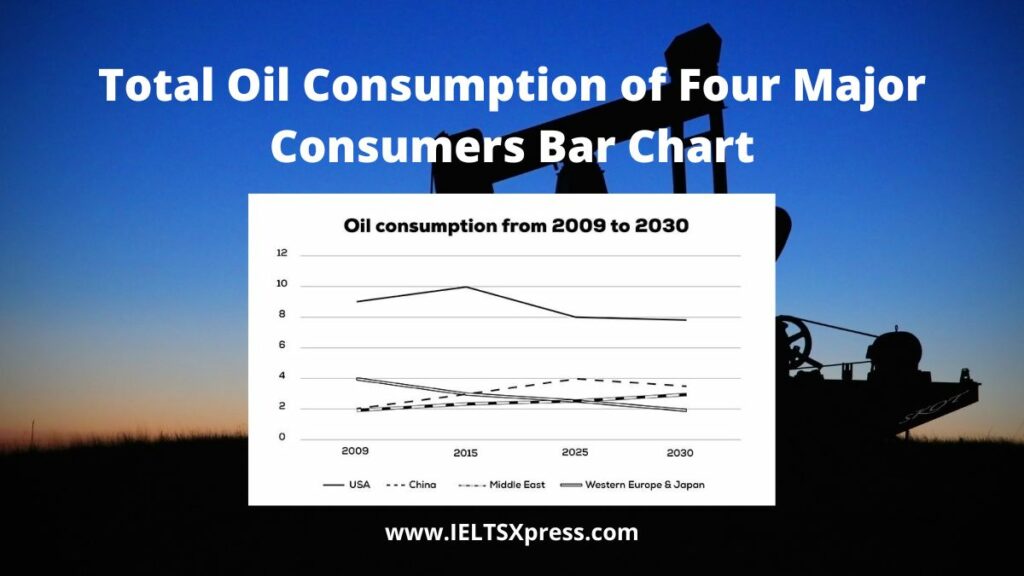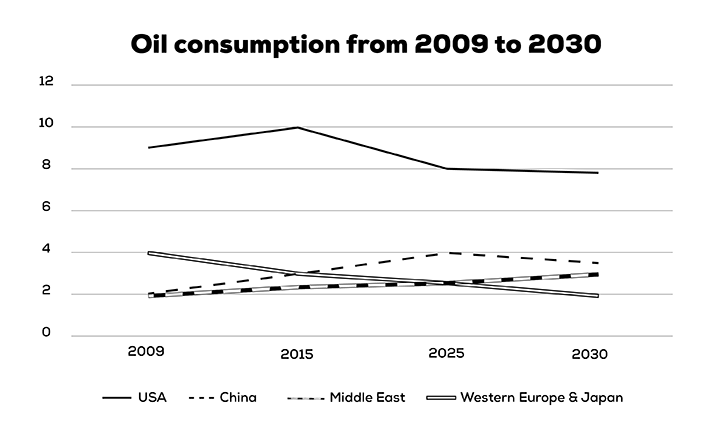Total Oil Consumption of Four Major Consumers Line Chart
You should spend about 20 minutes on this task.
Real IELTS Exam Question, Reported On:
Practice with Expert IELTS Tutors Online
Apply Code "IELTSXPRESS20" To Get 20% off on IELTS Mock Test
| India | 10th November 2022 |
The graph below shows information about the total oil consumption of four major consumers from 2009 to 2030
Summarise the information by selecting and reporting the main features and make comparisons where relevant. Write at least 150 words.
Total Oil Consumption of Four Major Consumers Line Chart
Sample Answer 1
Information regarding the gross consumption pattern of four major global oil consumers from 2009 till now and its projection till 2030 are depicted in the given graph.
At a glance, it is clear that though there were fluctuations in the overall consumption, a general decline in predicted in future.
As per the chart, the USA remained the topmost consumer since 2009 and is projected to retain this position till 2030. In 2009, it used about 9 million barrels, which was more than double than that of the consumption of Western Europe and Japan (4 million barrels). At this point of time, China and the Middle East consumed just 2 million barrels.
After a steady incline to 10 million barrels in 2015, which was the highest, the oil use in the US started shrinking, and is anticipated to settle at 6 million barrels by 2030. The consumption in China too grew, and is projected to hit the maximum of 4 million barrels by 2025. However, it is set to fall by a million by 2030.
When the oil consumption pattern in Western Europe and Japan exhibited a steady slip, and would settle under 2 million barrels, the consumption pattern in the Middle East is seen almost stationary at 2 million barrels over the period.
I E LT SX PRSES
Total Oil Consumption of Four Major Consumers Line Chart
The line graph gives information about the oil consumption of four different regions from 2009 until present, and predicted figures until 2030. Units are in millions of barrels per day.
Overall, the USA was by far the biggest consumer of oil from 2009 until present and is predicted to remain the biggest consumer until 2030. ieltsxpress
In 2009, oil consumption in the USA was around 9 million barrels per day. This figure rose to around 10 million barrels per day in 2015, before beginning to fall. Figures are predicted to continue falling to around 7.5 million barrels per day by 2030. Meanwhile, oil consumption in Western Europe and Japan was around 4 million barrels per day in 2009 and has been in decline since. Figures are predicted to reach 2 million barrels by 2030. ielt sx press
Oil consumption in China and the Middle East was around 2 million barrels per day each in 2009. By 2030, figures for China and the Middle East are predicted to reach 3.5 and 3 million barrels per day respectively. ielt sxp ress
The graph below shows information about the total oil consumption of four major consumers
The line chart depicts the numbers for oil use in four nations, the US, China, the Middle East and Western Europe and Japan over a period of 21 years from 2009 to 2030.
Overall, it is apparent that the US consumes most of the oil in first six years, but it is expected that oil consumption will be decreased in the coming years, while the Middle East and China are predicted to increase. ielt sxpress
To begin with, the United State, consumption recorded below than ten million in first six years from 2009 to 2015 but it is predicted that the consumption of oil Neill be decreased to just over 4 million in 2030. Coming to Western Europe and Japan. This nation also follows a similar trend as the US. I mean to say, the numbers began from 4 million barrels a day in 2009, but in the coming years, the numbers will have dwindled to 2 million.
Furthermore, with China and the Middle East. Both countries started and end with the same points, amounting for below than 2 million barrels per day in 2009, will be about 3 million in 2030 but in between time China consume a bit more oil than the Middle East. ieltsxpress





